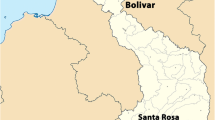Abstract
Subcellular fractionation is a valuable tool to follow protein traffic between cellular compartments. Here we detail a procedure for fractionating erythrocytes infected with the human malaria parasite P. falciparum using the bacterial pore-forming protein Streptolysin O (SLO). Additionally we describe an experimental protocol to determine protein topology by carrying out a protease protection assay on SLO-lysed infected erythrocytes.
Access this chapter
Tax calculation will be finalised at checkout
Purchases are for personal use only
Similar content being viewed by others
References
Maier AG, Rug M, O’Neill MT, Brown M, Chakravorty S, Szestak T et al (2008) Exported proteins required for virulence and rigidity of Plasmodium falciparum-infected human erythrocytes. Cell 134:48–61
Maier AG, Cooke BM, Cowman AF, Tilley L (2009) Malaria parasite proteins that remodel the host erythrocyte. Nat Rev Microbiol 7:341–354
Przyborski JM, Miller SK, Pfahler JM, Henrich PP, Rohrbach P, Crabb BS et al (2005) Trafficking of STEVOR to the Maurer’s clefts in Plasmodium falciparum-infected erythrocytes. EMBO J 24:2306–2317
Wickham ME, Rug M, Ralph SA, Klonis N, McFadden GI, Tilley L et al (2001) Trafficking and assembly of the cytoadherence complex in Plasmodium falciparum-infected human erythrocytes. EMBO J 20:5636–5649
Hiller NL, Bhattacharjee S, van Ooij C, Liolios K, Harrison T, Lopez-Estrano C et al (2004) A host-targeting signal in virulence proteins reveals a secretome in malarial infection. Science 306:1934–1937
Marti M, Good RT, Rug M, Knuepfer E, Cowman AF (2004) Targeting malaria virulence and remodeling proteins to the host erythrocyte. Science 306:1930–1933
Ansorge I, Benting J, Bhakdi S, Lingelbach K (1996) Protein sorting in Plasmodium falciparum-infected red blood cells permeabilized with the pore-forming protein streptolysin O. Biochem J 315:307–314
Dourmashkin RR, Rosse WF (1966) Morphologic changes in the membranes of red blood cells undergoing hemolysis. Am J Med 41:699–710
Duncan JL, Schlegel R (1975) Effect of streptolysin O on erythrocyte membranes, liposomes, and lipid dispersions. A protein-cholesterol interaction. J Cell Biol 67:160–174
Shany S, Bernheimer AW, Grushoff PS, Kim KS (1974) Evidence for membrane cholesterol as the common binding site for cereolysin, streptolysin O and saponin. Mol Cell Biochem 3:179–186
Ansorge I, Paprotka K, Bhakdi S, Lingelbach K (1997) Permeabilization of the erythrocyte membrane with streptolysin O allows access to the vacuolar membrane of Plasmodium falciparum and a molecular analysis of membrane topology. Mol Biochem Parasitol 84:259–261
Knapp B, Hundt E, Nau U, Kupper HA (1989) Molecular cloning, genomic structure and localization in a blood stage antigen of Plasmodium falciparum characterized by a serine stretch. Mol Biochem Parasitol 32:73–83
Knapp B, Hundt E, Kupper HA (1990) Plasmodium falciparum aldolase: gene structure and localization. Mol Biochem Parasitol 40:1–12
Blisnick T, Morales Betoulle ME, Barale JC, Uzureau P, Berry L, Desroses S et al (2000) Pfsbp1, a Maurer’s cleft Plasmodium falciparum protein, is associated with the erythrocyte skeleton. Mol Biochem Parasitol 111:107–121
Gunther K, Tummler M, Arnold HH, Ridley R, Goman M, Scaife JG et al (1991) An exported protein of Plasmodium falciparum is synthesized as an integral membrane protein. Mol Biochem Parasitol 46:149–157
Pinkney M, Beachey E, Kehoe M (1989) The thiol-activated toxin streptolysin O does not require a thiol group for cytolytic activity. Infect Immun 57:2553–2558
Pasvol G, Wilson RJ, Smalley ME, Brown J (1978) Separation of viable schizont-infected red cells of Plasmodium falciparum from human blood. Ann Trop Med Parasitol 72:87–88
Staalsoe T, Giha HA, Dodoo D, Theander TG, Hviid L (1999) Detection of antibodies to variant antigens on Plasmodium falciparum-infected erythrocytes by flow cytometry. Cytometry 35:329–336
Saul A, Myler P, Elliott T, Kidson C (1982) Purification of mature schizonts of Plasmodium falciparum on colloidal silica gradients. Bull World Health Organ 60:755–759
Rivadeneira EM, Wasserman M, Espinal CT (1983) Separation and concentration of schizonts of Plasmodium falciparum by Percoll gradients. J Protozool 30:367–370
Acknowledgement
J.M.P. is supported by DFG Grant PR1099/3-1 as part of the SPP1580. S.K. is supported by a postdoctoral DFG scholarship.
Author information
Authors and Affiliations
Corresponding author
Editor information
Editors and Affiliations
Rights and permissions
Copyright information
© 2015 Springer Science+Business Media New York
About this protocol
Cite this protocol
Külzer, S., Bittl, V., Przyborski, J.M. (2015). Fractionation of Plasmodium-Infected Human Red Blood Cells to Study Protein Trafficking. In: Tang, B. (eds) Membrane Trafficking. Methods in Molecular Biology, vol 1270. Humana Press, New York, NY. https://doi.org/10.1007/978-1-4939-2309-0_5
Download citation
DOI: https://doi.org/10.1007/978-1-4939-2309-0_5
Published:
Publisher Name: Humana Press, New York, NY
Print ISBN: 978-1-4939-2308-3
Online ISBN: 978-1-4939-2309-0
eBook Packages: Springer Protocols




